Crafting an Effective Letter of Assignment: A Comprehensive Guide with Sample

A letter of assignment is a critical document in various business, academic, and professional settings. It formally assigns responsibilities, tasks, or roles from one party to another. Understanding how to craft an effective letter of assignment can ensure clear communication and smooth transitions in responsibilities. This guide will explore the essential components of a letter of assignment, provide legal considerations, and offer a sample letter to help you draft your own.


Understanding the Letter of Assignment
What is a letter of assignment.
A letter of assignment is a document that formally assigns a specific task, responsibility, or job from one individual or organization to another. It is commonly used in settings such as journalism, where assignments are delegated to reporters, or in project management, where specific tasks are assigned to team members.
For more information on the role of assignments in organizational management, Harvard Business School provides a wealth of resources on organizational behavior.
Key Elements of a Letter of Assignment
Introduction : Clearly state the purpose of the letter.
Details of the Assignment : Specify the task or responsibility being assigned, including any relevant deadlines or expectations.
Resources and Authority : Outline any resources that will be provided to assist with the assignment and any authority the assignee has over others.
Expectations and Goals : Clearly define what success looks like for the assignment.
Duration of the Assignment : If applicable, state the start and end dates.
Contact Information : Provide contact details for someone who can offer assistance or answer questions related to the assignment.
To see a general template of business documents, including assignment letters, visit Purdue University’s Online Writing Lab.
Legal Considerations
When crafting a letter of assignment, it's essential to ensure that it does not violate any contractual agreements or employment laws. Consult legal resources or an attorney to confirm that all aspects of your letter are compliant with local and federal laws. The U.S. Small Business Administration offers guidelines on employment and labor laws that might be relevant.
Sample Letter of Assignment
Note: This sample is for illustrative purposes only and should be customized to meet specific needs and legal requirements.
[Your Name] [Your Position] [Your Company/Organization] [Your Address] [City, State, Zip Code] [Email Address] [Phone Number] [Date] [Recipient Name] [Recipient Position] [Company/Organization] [Recipient Address] [City, State, Zip Code] Dear [Recipient Name], Subject: Assignment of [Task/Responsibility/Project Name] I am writing to formally assign you the responsibility of [brief description of the task or responsibility]. This assignment will commence on [start date] and will conclude on [end date], unless extended by mutual agreement. Details of the Assignment: - **Task Description**: [Detailed description of the task, including any specific expectations or deliverables.] - **Resources Provided**: [List of resources or support to be provided, including access to systems, budget information, etc.] - **Authority**: You will have the authority to [describe any authority over staff, budgets, decisions]. - **Goals and Objectives**: The primary goal of this assignment is [describe what successful completion of the assignment looks like]. Please confirm your acceptance of this assignment by signing and returning a copy of this letter. Should you have any questions or require further clarification, do not hesitate to contact me directly at [your phone number] or [your email]. Thank you for your attention to this matter and your continued contribution to our team. Sincerely, [Your Signature (if sending a hard copy)] [Your Typed Name] [Your Position] [Enclosures: if any]
Best Practices for Letter of Assignment
Clarity and conciseness.
Ensure that the letter is clear and concise. Avoid ambiguity about the responsibilities or expectations to prevent misunderstandings.
After sending the letter, follow up to ensure that the recipient has understood everything and agrees to the terms laid out in the letter.
Record Keeping
Keep a copy of the signed letter for your records. This can be useful for future reference or in case of disputes.

50% OFF ONE WEEK ONLY
Quick Creator is the ultimate solution for digital marketers who need high-converting landing pages quickly and easily. Say goodbye to the old, time-consuming methods and hello to the future of digital marketing.

A well-crafted letter of assignment not only clarifies roles and responsibilities but also sets the stage for successful project execution and employee engagement. By adhering to legal standards and following the guidelines provided, you can ensure that these documents are both effective and compliant. For further reading on employment and assignment contracts, visit Harvard University's Employment and Labor Law page .
Create & Review All Your Contracts Online With LegalNow AI

© Copyright 2024 LegalNow - All Rights Reserved.

Free Assignment Letter Template

Assigning content to writers takes time if you do it right. It’s important to give your writers as much information as you can so they can create the content you need. An assignment letter should be in every content director’s — and every publication editor’s — toolkit. We’ve taken the guesswork out. You can download this Assignment Letter Template (Word Doc) today to get your writers on the right track. Download it, modify, add your logo and branding. It’s all yours.
Where should we send your FREE Assignment Letter Template?
- Name * First Last
- Consent * I consent to have this website store my submitted information so they can respond to my inquiry.
- Phone This field is for validation purposes and should be left unchanged.
- Sample Letters
FREE 9+ Sample Assignment Letter Templates in PDF | MS Word
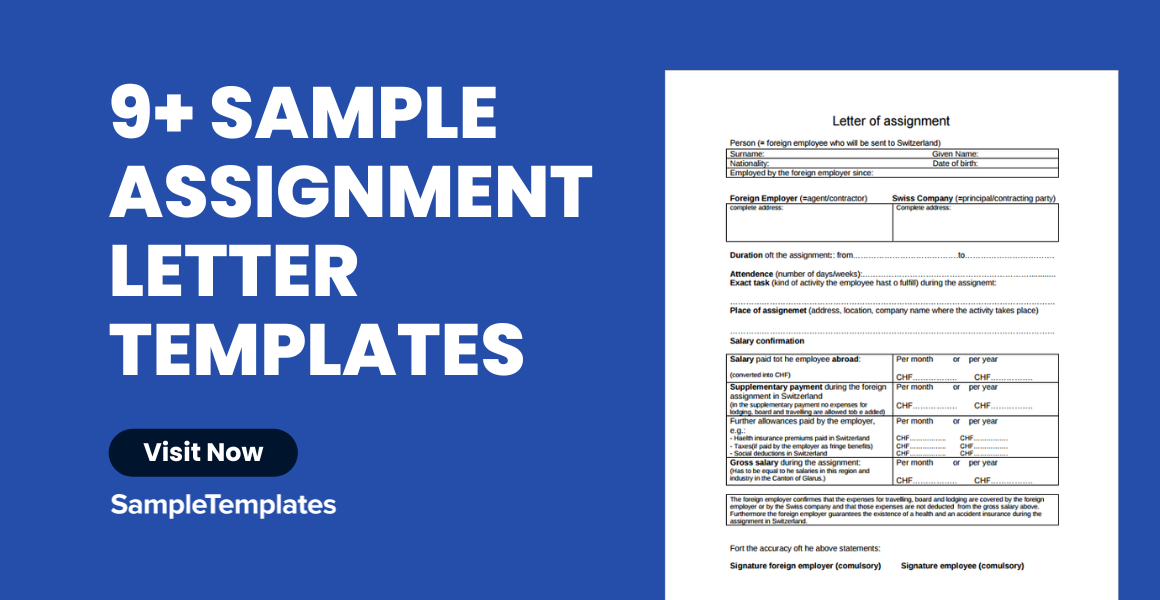
An assignment letter is a document that is used mostly in situations such as business bankruptcy and insolvency. It is a legal document which can be presented in courts when handling different cases. Examples of scenarios whereby this paper comes in are when a business owner is assigning a portion of his or her assets to a trustee for selling purposes and also when assigning specific rights to another person such as collecting payment on your behalf.
Assignment Letter
Sample personal business letter - 9+ documents in pdf, word, sample thank you letter to boss - 22+ free documents download ..., sample trademark assignment form - 7+ examples in pdf.
Our assignment templates get designed in the best way possible to usher you properly when creating one. An assignment letter template may also be said to be a Professional Letter of assignment or an assignment letter sample.
Salary Assignment Letter

Size: 130 KB
The top of the page should have the name of the person or the entity issuing the letter together with their personal information such as the telephone number, email address, and the postal address. Below that it should indicate that it is a letter of assignment to give the form an identity. Next should be the full names of the people or entity in the agreement alongside their personal information.
After that, mention the duration of the assignment and the location of where the deal takes place. The body of the document should be concluded by listing all the details of the money that they parties will be handling. Finally, the parties involved should sign the paper to seal the agreement.
Appraisal Assignment Letter
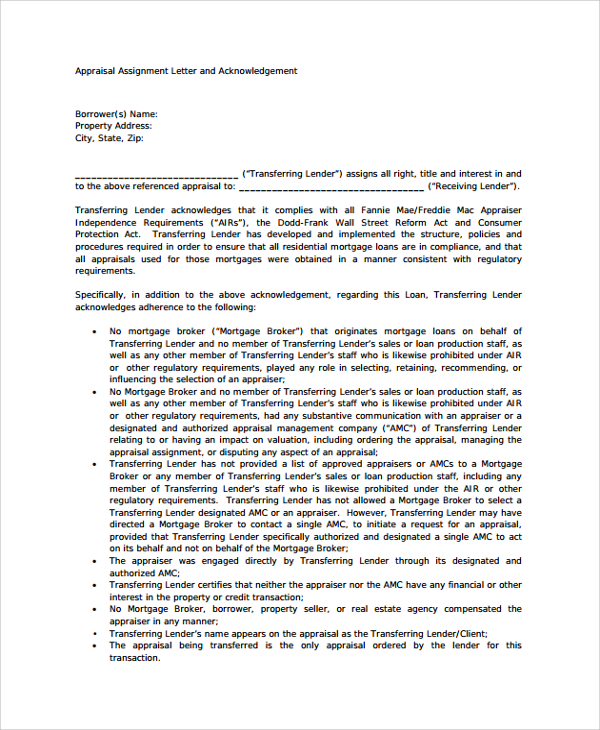
Size: 38 KB
The top of the form should read that the document is an appraisal assignment letter for easier identification. The name plus the postal address of the person or company issuing the appraisals should be listed next. After that, a declaration statement mentioning the names of the parties involved in the agreement should be put down saying who has assigned rights to the other.
The agreement should always comply with the standards set by law. Other acknowledgments that each party is supposed to heed to should also get listed in this document. The model should conclude by stating the period when the agreement will be active.
Voided Assignment Letter
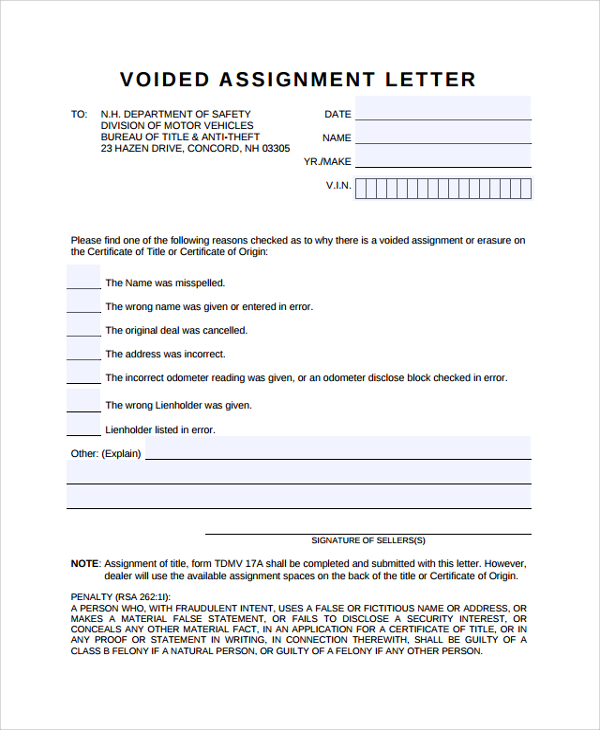
Size: 37 KB
The top of the model should read that it is a voided assignment letter for quick identification of the form. After that, on the left, the name of the person of corporate who is going to receive the document is listed together with other personal information such as a postal address and an email address.
The right should have the date of when the paper gets published. Finally, the reasons as to why there is a voided assignment letter must be on it and signatures of the parties involved should also be given to show that they agree with the stated reasons.
Incentive Assignment Letter
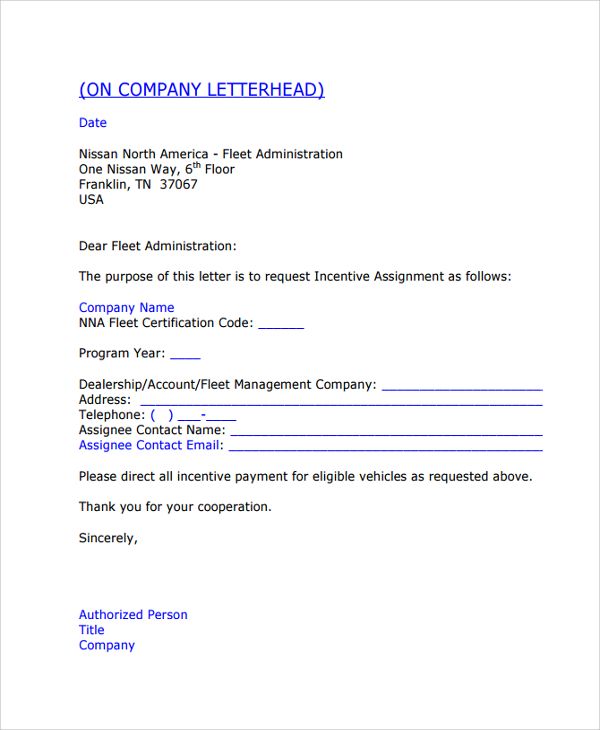
Size: 42 KB
The name of the company issuing the letter should be the first thing on the document and the date below that. Next should be the name and personal details of the person or entity meant to receive it. The incentive assignment should be listed giving all crucial information about it and contacts which the receiver can contact for further negotiations. Finally, it concludes with a short formal message to the receiver.
Professional Assignment Letter
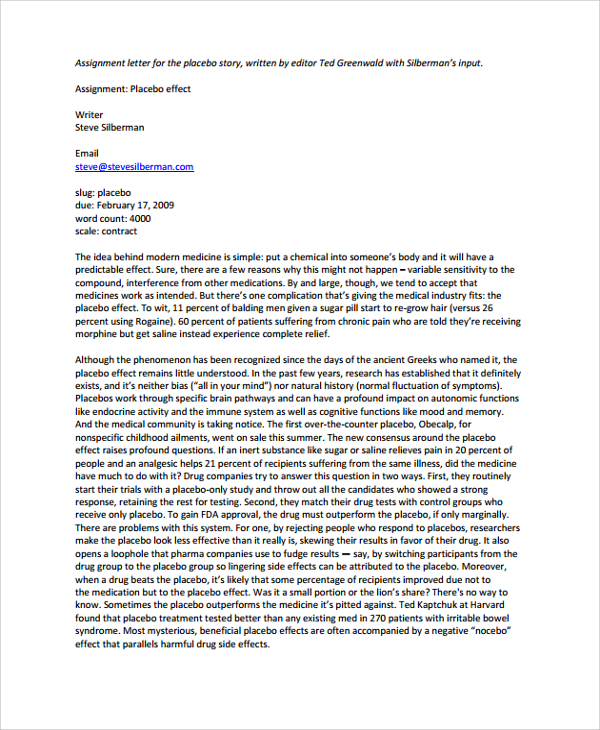
Size: 355 KB
Buddy Assignment Letter
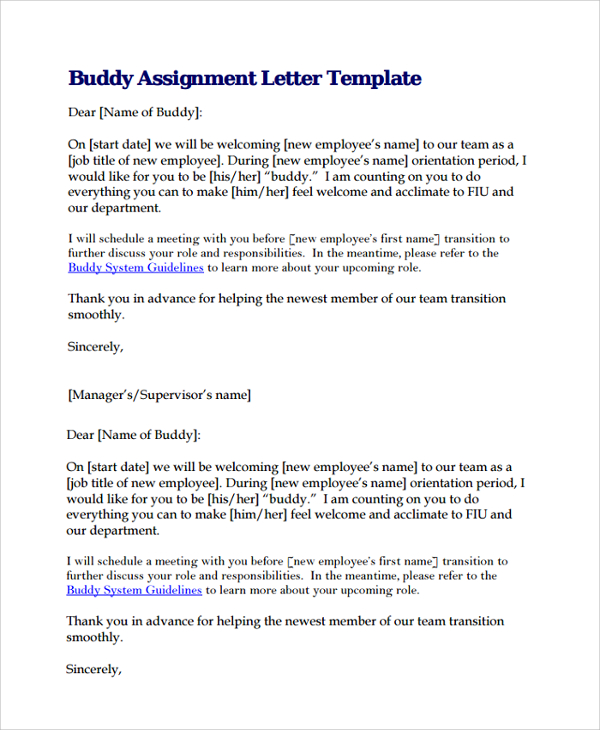
Size: 155 KB
Friendly Assignment Letter
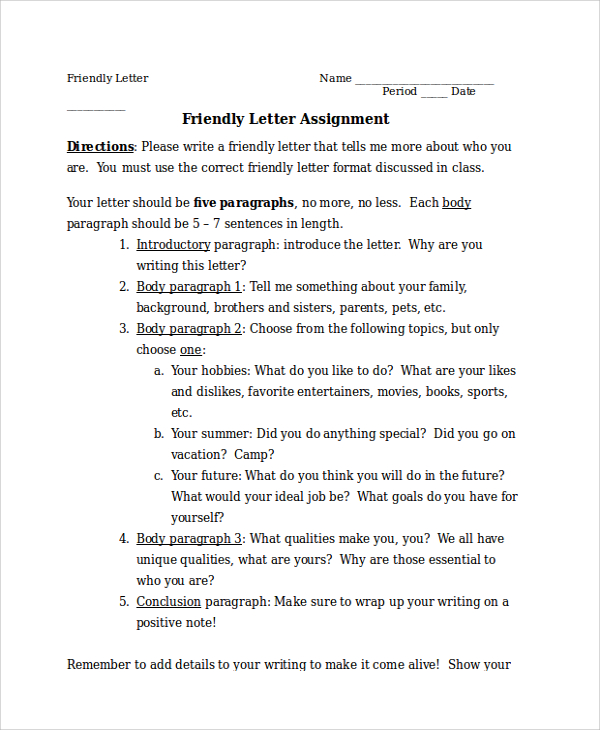
Size: 31 KB
Sample Assignment Letter
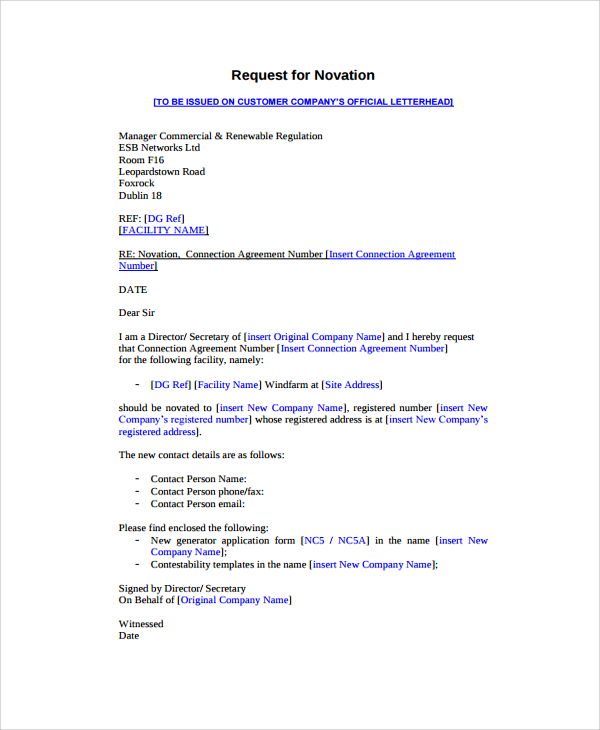
Size: 137 KB
Assignment Letter from Trainee
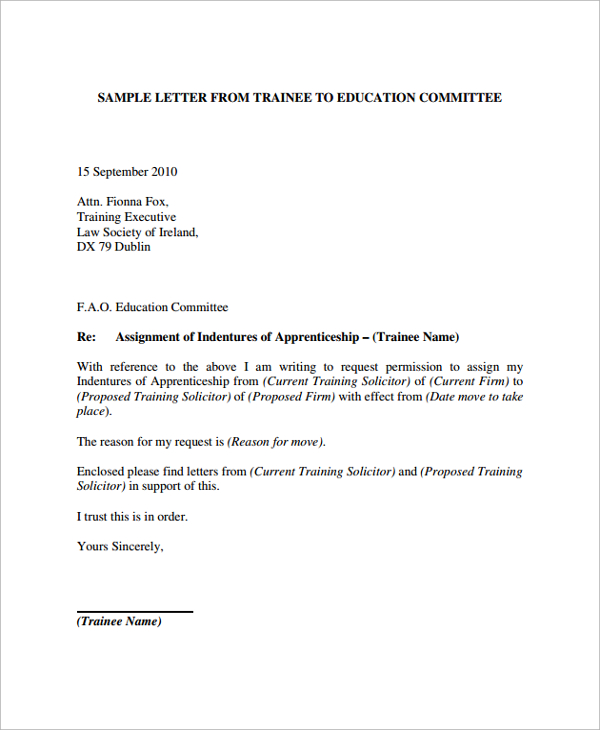
Volunteer Assignment Letter
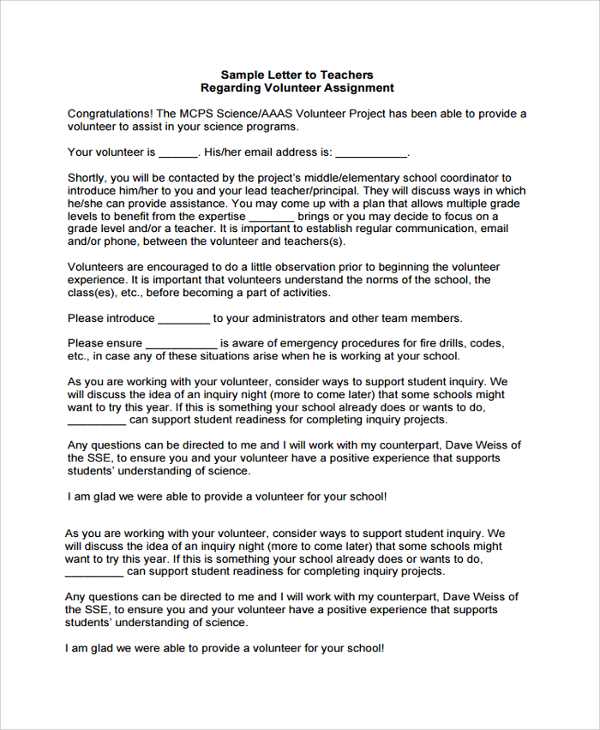
Size: 52 KB
What are the Advantages of Having our Assignment Letter Templates?
One may lack sufficient knowledge on what to include when forming this document; therefore, the main benefit of having our template is that it gives you the proper guidance on which information to include in your paper and an order of how to put it down.
Another advantage is that our templates are files which you can save on you PC; thus, you can make references from the file again in future when forming assignment letters. Finally, our templates are always designed to help you create one as per the standard legal requirements. You may also see Sample Personal Letters
How Have We Made our Assignment Letter Templates the Best for you?
Our models get worked on by the experts whom we have interviewed thoroughly and proven that they are talented. We also ensure that they have sufficient experience in the field for our templates to be as effective for you as possible. Another way we have made our templates the best for you is by making them editable such that you can do any modifications you prefer on them. Finally, they are printable for you to be able to make as many copies as you want. You may also see Friendly Letters
Which are the Most Crucial Aspects that I Should Entail in my Assignment Letter?
Always list the name of parties in the agreement and also sufficient personal information about them. Never forget to indicate the date you publish the model and the period of how long the contract will be valid. Ensure that both parties agree on what gets stated on the Professional Letters then seal the deal with signatures of each. Finally, since it is a legal document, always ensure that your agreement complies with the provisions of the law to avoid awful penalties.
We ensure that we meet the requirements of all our customers according to their needs. Those that would want a fully customed model can always communicate to us so that we can direct you to our experts to help them understand what kind of make you want. We have customer care agents that are always available to tend to all the inquiries you may have and the consultations you may need. Consider acquiring our accessible and affordable assignment letter template today, to guide you while creating the document you need.
If you have any DMCA issues on this post, please contact us !
Related Posts
Sample visa invitation letter templates, how to write an application letter for employment [ with samples ], sample community service letter templates, sample commitment letter templates, sample application letter templates, letterhead samples, sample visa sponsorship letter templates, application letter templates, sample job application cover letter templates, formal excuse letter templates, leave letter templates, sick leave letter templates, free 10+ sample inform letter templates in pdf, free 13+ sample closing business letter templates in pdf | ms word | google docs | pages, 10 free notice to quit letter samples & templates, sample assignment of contract - 6+ free documents download in ..., sample assignment of mortgage template - 9+ free documents ..., sample assignment agreement template - 9+ free documents ..., sample appointment letter - 28+ download free documents in pdf ....
- Product Development / Launch
- Critiques / Assessments
- Repositioning / Redesigning
- Print-to-Web / Multiplatform
- Promotion / Marketing
- Management Consulting
- Training / Facilitating
- Acoustic Guitar Magazine
- Afar Magazine
- Asiatica Magazine
- ConsumerReports.org
- Discovery.com
- Dwell Magazine
- Navigenics.com
- Surgical Techniques Online
- more projects
- About West Gold Editorial
- Michael Gold
ContentWise Blog
The assignment letter, an editor’s best friend.
By Susan West & Michael Gold on January 26, 2012
Sure, you and the writer had a long talk when you commissioned that story idea. But two months later the manuscript is on your desk, and who can remember what the article was supposed to be? That’s where an assignment letter comes in handy. After you and a freelancer have agreed on a story, recap the discussion in writing and send your letter (or e-mail message) to the writer. It will help you get the piece you want.
Once you’ve read through the guidelines below, have a look at our sample letter (a downloadable PDF document).
WHY WRITE IT?
- To build an editorial foundation for the story: A clear assignment letter puts you and the writer on the same wavelength. If your written description differs from the writer’s recollection, you have a chance to resolve the discrepancy before the first draft comes in. And when the manuscript arrives, the letter allows you to judge whether the writer delivered the story as promised. You can also circulate the letter to higher-ups to make sure they buy into the assignment and recall it later. When you distribute the manuscript to other editors for review, attach the letter so they too know what the idea was.
- To build a relationship with a writer: Writers want clear instruction; an assignment letter provides that and gives the writer something to refer to while reporting and writing. A careful summary of the story idea assures the writer that you’re a careful editor who wants to prevent those nasty surprises that so often pop up between writer and editor. The letter also lets you address a writer’s weaknesses—get two sources for every fact, avoid clichés, and so on.
WHAT’S IN IT?
- A clear, specific statement of the story’s concept, content, and approach: Quickly and specifically outline what the article will cover and the depth of information you expect, including perhaps the types of sources you desire (personal interviews, scientific studies, etc.). Send research materials you have collected. Enclose a sample story from your magazine that could serve as a model. Confirm the approach you have agreed to and, if you two have discussed them, outline the lead and structure.
- Your worries: Is the reporting going to be difficult? Say so. Are you concerned about the structure? Ask to see an outline. Are there points that absolutely have to be covered? Make sure the writer knows.
- Logistical information: Describe the magazine’s payment procedures, editing process, fact-checking needs; tell the writer if you’re going to be out of town and whether you prefer to work by phone or e-mail. You can create some of this information ahead of time to cut-and-paste into your assignment letters.
For more suggestions on working with writers, see our model rewrite letter and tips on getting the most from freelancers .
Posted in Magazines , Resources
Browse Blog by Topic
What’s new.

Connect With Us

Publishing Resources
- e-Newsletter
- ( For Clients Only )
Copyright © 2020 West Gold Editorial Consulting | Website by West Gold Editorial | Powered by WordPress
- Columbia University in the City of New York
- Office of Teaching, Learning, and Innovation
- University Policies
- Columbia Online
- Academic Calendar
- Resources and Technology
- Instructional Technologies
- Teaching in All Modalities
Designing Assignments for Learning
The rapid shift to remote teaching and learning meant that many instructors reimagined their assessment practices. Whether adapting existing assignments or creatively designing new opportunities for their students to learn, instructors focused on helping students make meaning and demonstrate their learning outside of the traditional, face-to-face classroom setting. This resource distills the elements of assignment design that are important to carry forward as we continue to seek better ways of assessing learning and build on our innovative assignment designs.
On this page:
Rethinking traditional tests, quizzes, and exams.
- Examples from the Columbia University Classroom
- Tips for Designing Assignments for Learning
Reflect On Your Assignment Design
Connect with the ctl.
- Resources and References

Cite this resource: Columbia Center for Teaching and Learning (2021). Designing Assignments for Learning. Columbia University. Retrieved [today’s date] from https://ctl.columbia.edu/resources-and-technology/teaching-with-technology/teaching-online/designing-assignments/
Traditional assessments tend to reveal whether students can recognize, recall, or replicate what was learned out of context, and tend to focus on students providing correct responses (Wiggins, 1990). In contrast, authentic assignments, which are course assessments, engage students in higher order thinking, as they grapple with real or simulated challenges that help them prepare for their professional lives, and draw on the course knowledge learned and the skills acquired to create justifiable answers, performances or products (Wiggins, 1990). An authentic assessment provides opportunities for students to practice, consult resources, learn from feedback, and refine their performances and products accordingly (Wiggins 1990, 1998, 2014).
Authentic assignments ask students to “do” the subject with an audience in mind and apply their learning in a new situation. Examples of authentic assignments include asking students to:
- Write for a real audience (e.g., a memo, a policy brief, letter to the editor, a grant proposal, reports, building a website) and/or publication;
- Solve problem sets that have real world application;
- Design projects that address a real world problem;
- Engage in a community-partnered research project;
- Create an exhibit, performance, or conference presentation ;
- Compile and reflect on their work through a portfolio/e-portfolio.
Noteworthy elements of authentic designs are that instructors scaffold the assignment, and play an active role in preparing students for the tasks assigned, while students are intentionally asked to reflect on the process and product of their work thus building their metacognitive skills (Herrington and Oliver, 2000; Ashford-Rowe, Herrington and Brown, 2013; Frey, Schmitt, and Allen, 2012).
It’s worth noting here that authentic assessments can initially be time consuming to design, implement, and grade. They are critiqued for being challenging to use across course contexts and for grading reliability issues (Maclellan, 2004). Despite these challenges, authentic assessments are recognized as beneficial to student learning (Svinicki, 2004) as they are learner-centered (Weimer, 2013), promote academic integrity (McLaughlin, L. and Ricevuto, 2021; Sotiriadou et al., 2019; Schroeder, 2021) and motivate students to learn (Ambrose et al., 2010). The Columbia Center for Teaching and Learning is always available to consult with faculty who are considering authentic assessment designs and to discuss challenges and affordances.
Examples from the Columbia University Classroom
Columbia instructors have experimented with alternative ways of assessing student learning from oral exams to technology-enhanced assignments. Below are a few examples of authentic assignments in various teaching contexts across Columbia University.
- E-portfolios: Statia Cook shares her experiences with an ePorfolio assignment in her co-taught Frontiers of Science course (a submission to the Voices of Hybrid and Online Teaching and Learning initiative); CUIMC use of ePortfolios ;
- Case studies: Columbia instructors have engaged their students in authentic ways through case studies drawing on the Case Consortium at Columbia University. Read and watch a faculty spotlight to learn how Professor Mary Ann Price uses the case method to place pre-med students in real-life scenarios;
- Simulations: students at CUIMC engage in simulations to develop their professional skills in The Mary & Michael Jaharis Simulation Center in the Vagelos College of Physicians and Surgeons and the Helene Fuld Health Trust Simulation Center in the Columbia School of Nursing;
- Experiential learning: instructors have drawn on New York City as a learning laboratory such as Barnard’s NYC as Lab webpage which highlights courses that engage students in NYC;
- Design projects that address real world problems: Yevgeniy Yesilevskiy on the Engineering design projects completed using lab kits during remote learning. Watch Dr. Yesilevskiy talk about his teaching and read the Columbia News article .
- Writing assignments: Lia Marshall and her teaching associate Aparna Balasundaram reflect on their “non-disposable or renewable assignments” to prepare social work students for their professional lives as they write for a real audience; and Hannah Weaver spoke about a sandbox assignment used in her Core Literature Humanities course at the 2021 Celebration of Teaching and Learning Symposium . Watch Dr. Weaver share her experiences.
Tips for Designing Assignments for Learning
While designing an effective authentic assignment may seem like a daunting task, the following tips can be used as a starting point. See the Resources section for frameworks and tools that may be useful in this effort.
Align the assignment with your course learning objectives
Identify the kind of thinking that is important in your course, the knowledge students will apply, and the skills they will practice using through the assignment. What kind of thinking will students be asked to do for the assignment? What will students learn by completing this assignment? How will the assignment help students achieve the desired course learning outcomes? For more information on course learning objectives, see the CTL’s Course Design Essentials self-paced course and watch the video on Articulating Learning Objectives .
Identify an authentic meaning-making task
For meaning-making to occur, students need to understand the relevance of the assignment to the course and beyond (Ambrose et al., 2010). To Bean (2011) a “meaning-making” or “meaning-constructing” task has two dimensions: 1) it presents students with an authentic disciplinary problem or asks students to formulate their own problems, both of which engage them in active critical thinking, and 2) the problem is placed in “a context that gives students a role or purpose, a targeted audience, and a genre.” (Bean, 2011: 97-98).
An authentic task gives students a realistic challenge to grapple with, a role to take on that allows them to “rehearse for the complex ambiguities” of life, provides resources and supports to draw on, and requires students to justify their work and the process they used to inform their solution (Wiggins, 1990). Note that if students find an assignment interesting or relevant, they will see value in completing it.
Consider the kind of activities in the real world that use the knowledge and skills that are the focus of your course. How is this knowledge and these skills applied to answer real-world questions to solve real-world problems? (Herrington et al., 2010: 22). What do professionals or academics in your discipline do on a regular basis? What does it mean to think like a biologist, statistician, historian, social scientist? How might your assignment ask students to draw on current events, issues, or problems that relate to the course and are of interest to them? How might your assignment tap into student motivation and engage them in the kinds of thinking they can apply to better understand the world around them? (Ambrose et al., 2010).
Determine the evaluation criteria and create a rubric
To ensure equitable and consistent grading of assignments across students, make transparent the criteria you will use to evaluate student work. The criteria should focus on the knowledge and skills that are central to the assignment. Build on the criteria identified, create a rubric that makes explicit the expectations of deliverables and share this rubric with your students so they can use it as they work on the assignment. For more information on rubrics, see the CTL’s resource Incorporating Rubrics into Your Grading and Feedback Practices , and explore the Association of American Colleges & Universities VALUE Rubrics (Valid Assessment of Learning in Undergraduate Education).
Build in metacognition
Ask students to reflect on what and how they learned from the assignment. Help students uncover personal relevance of the assignment, find intrinsic value in their work, and deepen their motivation by asking them to reflect on their process and their assignment deliverable. Sample prompts might include: what did you learn from this assignment? How might you draw on the knowledge and skills you used on this assignment in the future? See Ambrose et al., 2010 for more strategies that support motivation and the CTL’s resource on Metacognition ).
Provide students with opportunities to practice
Design your assignment to be a learning experience and prepare students for success on the assignment. If students can reasonably expect to be successful on an assignment when they put in the required effort ,with the support and guidance of the instructor, they are more likely to engage in the behaviors necessary for learning (Ambrose et al., 2010). Ensure student success by actively teaching the knowledge and skills of the course (e.g., how to problem solve, how to write for a particular audience), modeling the desired thinking, and creating learning activities that build up to a graded assignment. Provide opportunities for students to practice using the knowledge and skills they will need for the assignment, whether through low-stakes in-class activities or homework activities that include opportunities to receive and incorporate formative feedback. For more information on providing feedback, see the CTL resource Feedback for Learning .
Communicate about the assignment
Share the purpose, task, audience, expectations, and criteria for the assignment. Students may have expectations about assessments and how they will be graded that is informed by their prior experiences completing high-stakes assessments, so be transparent. Tell your students why you are asking them to do this assignment, what skills they will be using, how it aligns with the course learning outcomes, and why it is relevant to their learning and their professional lives (i.e., how practitioners / professionals use the knowledge and skills in your course in real world contexts and for what purposes). Finally, verify that students understand what they need to do to complete the assignment. This can be done by asking students to respond to poll questions about different parts of the assignment, a “scavenger hunt” of the assignment instructions–giving students questions to answer about the assignment and having them work in small groups to answer the questions, or by having students share back what they think is expected of them.
Plan to iterate and to keep the focus on learning
Draw on multiple sources of data to help make decisions about what changes are needed to the assignment, the assignment instructions, and/or rubric to ensure that it contributes to student learning. Explore assignment performance data. As Deandra Little reminds us: “a really good assignment, which is a really good assessment, also teaches you something or tells the instructor something. As much as it tells you what students are learning, it’s also telling you what they aren’t learning.” ( Teaching in Higher Ed podcast episode 337 ). Assignment bottlenecks–where students get stuck or struggle–can be good indicators that students need further support or opportunities to practice prior to completing an assignment. This awareness can inform teaching decisions.
Triangulate the performance data by collecting student feedback, and noting your own reflections about what worked well and what did not. Revise the assignment instructions, rubric, and teaching practices accordingly. Consider how you might better align your assignment with your course objectives and/or provide more opportunities for students to practice using the knowledge and skills that they will rely on for the assignment. Additionally, keep in mind societal, disciplinary, and technological changes as you tweak your assignments for future use.
Now is a great time to reflect on your practices and experiences with assignment design and think critically about your approach. Take a closer look at an existing assignment. Questions to consider include: What is this assignment meant to do? What purpose does it serve? Why do you ask students to do this assignment? How are they prepared to complete the assignment? Does the assignment assess the kind of learning that you really want? What would help students learn from this assignment?
Using the tips in the previous section: How can the assignment be tweaked to be more authentic and meaningful to students?
As you plan forward for post-pandemic teaching and reflect on your practices and reimagine your course design, you may find the following CTL resources helpful: Reflecting On Your Experiences with Remote Teaching , Transition to In-Person Teaching , and Course Design Support .
The Columbia Center for Teaching and Learning (CTL) is here to help!
For assistance with assignment design, rubric design, or any other teaching and learning need, please request a consultation by emailing [email protected] .
Transparency in Learning and Teaching (TILT) framework for assignments. The TILT Examples and Resources page ( https://tilthighered.com/tiltexamplesandresources ) includes example assignments from across disciplines, as well as a transparent assignment template and a checklist for designing transparent assignments . Each emphasizes the importance of articulating to students the purpose of the assignment or activity, the what and how of the task, and specifying the criteria that will be used to assess students.
Association of American Colleges & Universities (AAC&U) offers VALUE ADD (Assignment Design and Diagnostic) tools ( https://www.aacu.org/value-add-tools ) to help with the creation of clear and effective assignments that align with the desired learning outcomes and associated VALUE rubrics (Valid Assessment of Learning in Undergraduate Education). VALUE ADD encourages instructors to explicitly state assignment information such as the purpose of the assignment, what skills students will be using, how it aligns with course learning outcomes, the assignment type, the audience and context for the assignment, clear evaluation criteria, desired formatting, and expectations for completion whether individual or in a group.
Villarroel et al. (2017) propose a blueprint for building authentic assessments which includes four steps: 1) consider the workplace context, 2) design the authentic assessment; 3) learn and apply standards for judgement; and 4) give feedback.
References
Ambrose, S. A., Bridges, M. W., & DiPietro, M. (2010). Chapter 3: What Factors Motivate Students to Learn? In How Learning Works: Seven Research-Based Principles for Smart Teaching . Jossey-Bass.
Ashford-Rowe, K., Herrington, J., and Brown, C. (2013). Establishing the critical elements that determine authentic assessment. Assessment & Evaluation in Higher Education. 39(2), 205-222, http://dx.doi.org/10.1080/02602938.2013.819566 .
Bean, J.C. (2011). Engaging Ideas: The Professor’s Guide to Integrating Writing, Critical Thinking, and Active Learning in the Classroom . Second Edition. Jossey-Bass.
Frey, B. B, Schmitt, V. L., and Allen, J. P. (2012). Defining Authentic Classroom Assessment. Practical Assessment, Research, and Evaluation. 17(2). DOI: https://doi.org/10.7275/sxbs-0829
Herrington, J., Reeves, T. C., and Oliver, R. (2010). A Guide to Authentic e-Learning . Routledge.
Herrington, J. and Oliver, R. (2000). An instructional design framework for authentic learning environments. Educational Technology Research and Development, 48(3), 23-48.
Litchfield, B. C. and Dempsey, J. V. (2015). Authentic Assessment of Knowledge, Skills, and Attitudes. New Directions for Teaching and Learning. 142 (Summer 2015), 65-80.
Maclellan, E. (2004). How convincing is alternative assessment for use in higher education. Assessment & Evaluation in Higher Education. 29(3), June 2004. DOI: 10.1080/0260293042000188267
McLaughlin, L. and Ricevuto, J. (2021). Assessments in a Virtual Environment: You Won’t Need that Lockdown Browser! Faculty Focus. June 2, 2021.
Mueller, J. (2005). The Authentic Assessment Toolbox: Enhancing Student Learning through Online Faculty Development . MERLOT Journal of Online Learning and Teaching. 1(1). July 2005. Mueller’s Authentic Assessment Toolbox is available online.
Schroeder, R. (2021). Vaccinate Against Cheating With Authentic Assessment . Inside Higher Ed. (February 26, 2021).
Sotiriadou, P., Logan, D., Daly, A., and Guest, R. (2019). The role of authentic assessment to preserve academic integrity and promote skills development and employability. Studies in Higher Education. 45(111), 2132-2148. https://doi.org/10.1080/03075079.2019.1582015
Stachowiak, B. (Host). (November 25, 2020). Authentic Assignments with Deandra Little. (Episode 337). In Teaching in Higher Ed . https://teachinginhighered.com/podcast/authentic-assignments/
Svinicki, M. D. (2004). Authentic Assessment: Testing in Reality. New Directions for Teaching and Learning. 100 (Winter 2004): 23-29.
Villarroel, V., Bloxham, S, Bruna, D., Bruna, C., and Herrera-Seda, C. (2017). Authentic assessment: creating a blueprint for course design. Assessment & Evaluation in Higher Education. 43(5), 840-854. https://doi.org/10.1080/02602938.2017.1412396
Weimer, M. (2013). Learner-Centered Teaching: Five Key Changes to Practice . Second Edition. San Francisco: Jossey-Bass.
Wiggins, G. (2014). Authenticity in assessment, (re-)defined and explained. Retrieved from https://grantwiggins.wordpress.com/2014/01/26/authenticity-in-assessment-re-defined-and-explained/
Wiggins, G. (1998). Teaching to the (Authentic) Test. Educational Leadership . April 1989. 41-47.
Wiggins, Grant (1990). The Case for Authentic Assessment . Practical Assessment, Research & Evaluation , 2(2).
Wondering how AI tools might play a role in your course assignments?
See the CTL’s resource “Considerations for AI Tools in the Classroom.”
This website uses cookies to identify users, improve the user experience and requires cookies to work. By continuing to use this website, you consent to Columbia University's use of cookies and similar technologies, in accordance with the Columbia University Website Cookie Notice .
- Sign Up for Mailing List
- Search Search
Username or Email Address
Remember Me

- About MIT Comparative Media Studies/Writing
- Diversity Statements
- Visitors and Postdoctoral Associates
- Staff and Research Scientists
- Undergraduate Studies
- Graduate Program in Science Writing
- Appointments
- Writing Together Online
- First-year Essay Evaluation
- Graduate Writing Exam
- Communication Requirement
- English Language Studies (English for Bilingual Students)
- CMS Subjects
- Writing Subjects
- English Language Studies
- MIT OpenCourseWare
- Research Groups
- Books, Articles, and Theses
- Guidelines for the Karmel Writing Prizes
- Submit Your Karmel Prize Entry
- Scope : The best of the Graduate Program in Science Writing
- Angles : The best of MIT Introductory Writing
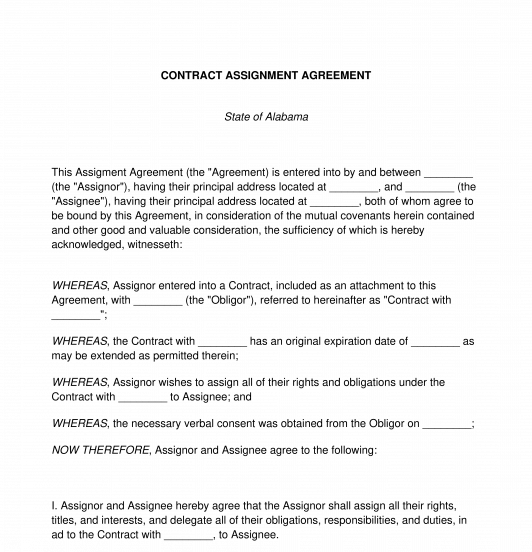
How does it work?
1. choose this template.
Start by clicking on "Fill out the template"
2. Complete the document
Answer a few questions and your document is created automatically.
3. Save - Print
Your document is ready! You will receive it in Word and PDF formats. You will be able to modify it.
Contract Assignment Agreement
Rating: 4.8 - 105 votes
This Contract Assignment Agreement document is used to transfer rights and responsibilities under an original contract from one Party, known as the Assignor, to another, known as the Assignee. The Assignor who was a Party to the original contract can use this document to assign their rights under the original contract to the Assignee, as well as delegating their duties under the original contract to that Assignee. For example, a nanny who as contracted with a family to watch their children but is no longer able to due to a move could assign their rights and responsibilities under the original service contract to a new childcare provider.
How to use this document
Prior to using this document, the original contract is consulted to be sure that an assignment is not prohibited and that any necessary permissions from the other Party to the original contract, known as the Obligor, have been obtained. Once this has been done, the document can be used. The Agreement contains important information such as the identities of all parties to the Agreement, the expiration date (if any) of the original contract, whether the original contract requires the Obligor's consent before assigning rights and, if so, the form of consent that the Assignor obtained and when, and which state's laws will govern the interpretation of the Agreement.
If the Agreement involves the transfer of land from one Party to another , the document will include information about where the property is located, as well as space for the document to be recorded in the county's official records, and a notary page customized for the land's location so that the document can be notarized.
Once the document has been completed, it is signed, dated, and copies are given to all concerned parties , including the Assignor, the Assignee, and the Obligor. If the Agreement concerns the transfer of land, the Agreement is then notarized and taken to be recorded so that there is an official record that the property was transferred.
Applicable law
The assignment of contracts that involve the provision of services is governed by common law in the " Second Restatement of Contracts " (the "Restatement"). The Restatement is a non-binding authority in all of U.S common law in the area of contracts and commercial transactions. Though the Restatement is non-binding, it is frequently cited by courts in explaining their reasoning in interpreting contractual disputes.
The assignment of contracts for sale of goods is governed by the Uniform Commercial Code (the "UCC") in § 2-209 Modification, Rescission and Waiver .
How to modify the template
You fill out a form. The document is created before your eyes as you respond to the questions.
At the end, you receive it in Word and PDF formats. You can modify it and reuse it.
Other names for the document:
Assignment Agreement, Assignment of Contract Agreement, Contract Assignment, Assignment of Contract Contract, Contract Transfer Agreement
Country: United States
General Business Documents - Other downloadable templates of legal documents
- Amendment to Agreement
- Loan Agreement
- Loan Agreement Modification
- Release of Loan Agreement
- Non-Compete Agreement
- Partnership Dissolution Agreement
- Notice of Withdrawal from Partnership
- Power Of Attorney
- Debt Acknowledgment Form
- Meeting Minutes
- Request to Alter Contract
- Release Agreement
- Guaranty Agreement
- Joint Venture Agreement
- Debt Settlement Agreement
- Breach of Contract Notice
- Corporate Proxy
- Mutual Rescission and Release Agreement
- Notice for Non-Renewal of Contract
- Meeting Notice
- Other downloadable templates of legal documents

Assignment of Contract
Jump to section, what is an assignment of contract.
An assignment of contract is a legal term that describes the process that occurs when the original party (assignor) transfers their rights and obligations under their contract to a third party (assignee). When an assignment of contract happens, the original party is relieved of their contractual duties, and their role is replaced by the approved incoming party.
How Does Assignment of Contract Work?
An assignment of contract is simpler than you might think.
The process starts with an existing contract party who wishes to transfer their contractual obligations to a new party.
When this occurs, the existing contract party must first confirm that an assignment of contract is permissible under the legally binding agreement . Some contracts prohibit assignments of contract altogether, and some require the other parties of the agreement to agree to the transfer. However, the general rule is that contracts are freely assignable unless there is an explicit provision that says otherwise.
In other cases, some contracts allow an assignment of contract without any formal notification to other contract parties. If this is the case, once the existing contract party decides to reassign his duties, he must create a “Letter of Assignment ” to notify any other contract signers of the change.
The Letter of Assignment must include details about who is to take over the contractual obligations of the exiting party and when the transfer will take place. If the assignment is valid, the assignor is not required to obtain the consent or signature of the other parties to the original contract for the valid assignment to take place.
Check out this article to learn more about how assigning a contract works.
Contract Assignment Examples
Contract assignments are great tools for contract parties to use when they wish to transfer their commitments to a third party. Here are some examples of contract assignments to help you better understand them:
Anna signs a contract with a local trash company that entitles her to have her trash picked up twice a week. A year later, the trash company transferred her contract to a new trash service provider. This contract assignment effectively makes Anna’s contract now with the new service provider.
Hasina enters a contract with a national phone company for cell phone service. The company goes into bankruptcy and needs to close its doors but decides to transfer all current contracts to another provider who agrees to honor the same rates and level of service. The contract assignment is completed, and Hasina now has a contract with the new phone company as a result.
Here is an article where you can find out more about contract assignments.
Assignment of Contract in Real Estate
Assignment of contract is also used in real estate to make money without going the well-known routes of buying and flipping houses. When real estate LLC investors use an assignment of contract, they can make money off properties without ever actually buying them by instead opting to transfer real estate contracts .
This process is called real estate wholesaling.
Real Estate Wholesaling
Real estate wholesaling consists of locating deals on houses that you don’t plan to buy but instead plan to enter a contract to reassign the house to another buyer and pocket the profit.
The process is simple: real estate wholesalers negotiate purchase contracts with sellers. Then, they present these contracts to buyers who pay them an assignment fee for transferring the contract.
This process works because a real estate purchase agreement does not come with the obligation to buy a property. Instead, it sets forth certain purchasing parameters that must be fulfilled by the buyer of the property. In a nutshell, whoever signs the purchase contract has the right to buy the property, but those rights can usually be transferred by means of an assignment of contract.
This means that as long as the buyer who’s involved in the assignment of contract agrees with the purchasing terms, they can legally take over the contract.
But how do real estate wholesalers find these properties?
It is easier than you might think. Here are a few examples of ways that wholesalers find cheap houses to turn a profit on:
- Direct mailers
- Place newspaper ads
- Make posts in online forums
- Social media posts
The key to finding the perfect home for an assignment of contract is to locate sellers that are looking to get rid of their properties quickly. This might be a family who is looking to relocate for a job opportunity or someone who needs to make repairs on a home but can’t afford it. Either way, the quicker the wholesaler can close the deal, the better.
Once a property is located, wholesalers immediately go to work getting the details ironed out about how the sale will work. Transparency is key when it comes to wholesaling. This means that when a wholesaler intends to use an assignment of contract to transfer the rights to another person, they are always upfront about during the preliminary phases of the sale.
In addition to this practice just being good business, it makes sure the process goes as smoothly as possible later down the line. Wholesalers are clear in their intent and make sure buyers know that the contract could be transferred to another buyer before the closing date arrives.
After their offer is accepted and warranties are determined, wholesalers move to complete a title search . Title searches ensure that sellers have the right to enter into a purchase agreement on the property. They do this by searching for any outstanding tax payments, liens , or other roadblocks that could prevent the sale from going through.
Wholesalers also often work with experienced real estate lawyers who ensure that all of the legal paperwork is forthcoming and will stand up in court. Lawyers can also assist in the contract negotiation process if needed but often don’t come in until the final stages.
If the title search comes back clear and the real estate lawyer gives the green light, the wholesaler will immediately move to locate an entity to transfer the rights to buy.
One of the most attractive advantages of real estate wholesaling is that very little money is needed to get started. The process of finding a seller, negotiating a price, and performing a title search is an extremely cheap process that almost anyone can do.
On the other hand, it is not always a positive experience. It can be hard for wholesalers to find sellers who will agree to sell their homes for less than the market value. Even when they do, there is always a chance that the transferred buyer will back out of the sale, which leaves wholesalers obligated to either purchase the property themselves or scramble to find a new person to complete an assignment of contract with.
Learn more about assignment of contract in real estate by checking out this article .

Who Handles Assignment of Contract?
The best person to handle an assignment of contract is an attorney. Since these are detailed legal documents that deal with thousands of dollars, it is never a bad idea to have a professional on your side. If you need help with an assignment of contract or signing a business contract , post a project on ContractsCounsel. There, you can connect with attorneys who know everything there is to know about assignment of contract amendment and can walk you through the whole process.
ContractsCounsel is not a law firm, and this post should not be considered and does not contain legal advice. To ensure the information and advice in this post are correct, sufficient, and appropriate for your situation, please consult a licensed attorney. Also, using or accessing ContractsCounsel's site does not create an attorney-client relationship between you and ContractsCounsel.
Meet some of our Lawyers
28+ years experience. Licensed in Colorado and New York. Areas of expertise: estate planning, wills and trusts; trademark law; patent law; contracts and licensing; small business organization and counseling.
Angela Hayden is an accomplished and driven attorney with a diverse professional background that sets her apart. Having served as a former Assistant Public Defender in Allegheny County, Angela acquired invaluable expertise in navigating the complexities of the criminal justice system. Her trial experience spans a wide range of cases, from minor retail theft to complex criminal homicide, demonstrating her ability to deliver successful outcomes for her clients. Prior to her focus on criminal defense, Angela honed her skills in public policy and political consulting through her work with both the Pennsylvania and United States House of Representatives. This experience provided her with a deep understanding of the intricacies of public policy and the ability to offer strategic guidance to clients. Angela's career also took her to a civil defense firm, where she traveled across the country, defending clients in litigation. This experience enhanced her ability to handle complex civil matters and strengthened her litigation skills. In addition to her expertise in criminal defense and civil litigation, Angela has demonstrated her proficiency in employment law, providing guidance and consultation to small businesses and non-profit organizations. Her keen insight into employment law matters ensures that businesses operate within legal boundaries while fostering a positive work environment. Furthermore, Angela is a licensed realtor, well-versed in residential real estate transactions. This additional knowledge allows her to offer comprehensive legal support to clients involved in real estate matters, ensuring their interests are protected throughout the process. Angela holds a degree from Hampton University and obtained her Juris Doctor from the University of Dayton School of Law. She is pursuing a Master of Business Administration. She is licensed to practice law in Pennsylvania and the District of Columbia, demonstrating her commitment to providing exceptional legal services in multiple jurisdictions. With her extensive experience and passion for achieving favorable outcomes for her clients, Angela Hayden is a dedicated advocate ready to guide you through your legal journey.
Seasoned corporate, business and real estate attorney with 30 years experience managing private practice groups and in-house legal functions for publicly traded, privately held, and family companies.
I am an experienced family law attorney licensed in California and Florida with over 13 years of experience.
I have worked for over 20 years in the areas of family law, business formation, contracts and real estate law. In the area of family law, I represent clients in all areas of family law including child custody, child support, spousal support and marital property division as well as preparing prenuptial and separation agreements. I am experienced in real estate law, including commercial and residential leases, preparing various types of real estate related contracts. I am also experienced in business formation among other business law matters. I currently work in the area of grant management with the Small Business Administration.
Oliver Keene is not your typical attorney. With a personal touch and a passion for helping others, he goes above and beyond to provide exceptional legal services. Born and raised in the heart of the Appalachian coalfields, Oliver understands the value of hard work and perseverance. His small-town upbringing instilled in him a deep sense of community and a commitment to making a difference in people's lives. Oliver's journey in the legal field began with a Bachelor's degree in Criminal Justice from Bluefield University. He went on to earn his Juris Doctorate from Lincoln Memorial University - Duncan School of Law, where he excelled in his studies and developed a strong foundation in law. Throughout his career, Oliver has gained invaluable experience working as a public defender, an attorney advisor for the Small Business Administration, and in various legal roles. With a focus on estate planning and business law, Oliver is dedicated to helping individuals and families protect their assets, plan for the future, and navigate the complexities of the legal system. His approachable demeanor, attention to detail, and genuine care for his clients set him apart. Oliver's clients can trust that he will go the extra mile to ensure their legal needs are met with the utmost professionalism and personalized service. Outside of his legal practice, Oliver enjoys spending time with his wife and daughter, exploring the great outdoors, and indulging in his passion for hunting and fishing. His commitment to serving military families is evident in his offering of discounted services as a token of gratitude for their sacrifices. When you choose Oliver Keene as your attorney, you're not just hiring a legal professional - you're gaining a trusted advisor and a compassionate advocate. With Oliver by your side, you can have confidence that your legal matters will be handled with the highest level of expertise and care.
Sage Law Firm S.
Dean represents client in all manners of tax controversy and provides comprehensive business consulting to corporations, LLCs, and non-profits. He has worked with multi-national companies, but most enjoys assisting small businesses with all legal matters from formation to dissolution. Dean routinely represents individuals and businesses before the IRS and various state taxation agencies. From audits to appeals, he works closely with his clients to reach favorable outcomes and beneficial resolutions. Though he assists many clients in his home state of California, Dean values working with a diverse clientele throughout the country.
Find the best lawyer for your project

Quick, user friendly and one of the better ways I've come across to get ahold of lawyers willing to take new clients.
Need help with a Contract Agreement?
Post Your Project
Get Free Bids to Compare
Hire Your Lawyer
CONTRACT LAWYERS BY TOP CITIES
- Austin Contracts Lawyers
- Boston Contracts Lawyers
- Chicago Contracts Lawyers
- Dallas Contracts Lawyers
- Denver Contracts Lawyers
- Houston Contracts Lawyers
- Los Angeles Contracts Lawyers
- New York Contracts Lawyers
- Phoenix Contracts Lawyers
- San Diego Contracts Lawyers
- Tampa Contracts Lawyers
ASSIGNMENT OF CONTRACT LAWYERS BY CITY
- Austin Assignment Of Contract Lawyers
- Boston Assignment Of Contract Lawyers
- Chicago Assignment Of Contract Lawyers
- Dallas Assignment Of Contract Lawyers
- Denver Assignment Of Contract Lawyers
- Houston Assignment Of Contract Lawyers
- Los Angeles Assignment Of Contract Lawyers
- New York Assignment Of Contract Lawyers
- Phoenix Assignment Of Contract Lawyers
- San Diego Assignment Of Contract Lawyers
- Tampa Assignment Of Contract Lawyers
Contracts Counsel was incredibly helpful and easy to use. I submitted a project for a lawyer's help within a day I had received over 6 proposals from qualified lawyers. I submitted a bid that works best for my business and we went forward with the project.
I never knew how difficult it was to obtain representation or a lawyer, and ContractsCounsel was EXACTLY the type of service I was hoping for when I was in a pinch. Working with their service was efficient, effective and made me feel in control. Thank you so much and should I ever need attorney services down the road, I'll certainly be a repeat customer.
I got 5 bids within 24h of posting my project. I choose the person who provided the most detailed and relevant intro letter, highlighting their experience relevant to my project. I am very satisfied with the outcome and quality of the two agreements that were produced, they actually far exceed my expectations.
How It Works
Want to speak to someone.
Get in touch below and we will schedule a time to connect!
Find lawyers and attorneys by city
Academic Resources
- Academic Calendar
- Academic Catalog
- Academic Success
- BlueM@il (Email)
- Campus Connect
- DePaul Central
- Desire2Learn (D2L)
Campus Resources
- Campus Security
- Campus Maps
University Resources
- Technology Help Desk
Information For
- Alumni & Friends
- Current Students
- Faculty & Staff
- Teaching Guides
- How Students Learn
- Course Design
- Instructional Methods
- Aligning with Learning Goals
- Critical Thinking
- Deterring Plagiarism
- Integrative Learning
- Feedback & Grading
- Learning Activities
- Flex Teaching
- Online Teaching
- Scholarship of Teaching and Learning
- Reflective Practice
- Inclusive Teaching
- Teaching at DePaul
- Support Services
- Technology Tools
Teaching Commons > Teaching Guides > Assignment Design > Writing
Designing Writing Assignments

Well-designed writing assignments, in short, lead directly to student learning. In doing so, well–designed writing assignments help you achieve your most central student-learning goals.
What's on This Page?
You’ll find a list of general assignment design principles directly below and then a design template that can help you apply best practices and create an effective and clear/easy-to-understand writing assignment.
Some General Principles
- Clearly link each assignment to the course goals and learning outcomes.
- Break large, high-stakes assignments into multiple, low-stakes assignments .
- Identify the purpose, audience, and genre (e.g. book review, reflection letter) for the assignment.
- Design assignments around real-world issues and events to engage and motivate students.
- Link directly to assignment readings (in your course reserves , for example)
- Provide model responses to the assignment from previous students whose permission you've received to anonymously share their work. Make sure to take time to discuss these models with your students in class. Be explicit about what makes them successful.
- Provide supporting structures such as templates, peer review, multiple drafts, and guidelines for library research.
- Provide grading guidelines for the assignment in the form of rubrics and examples of acceptable and unacceptable work.
- Revise assignments for next term based on student performance and feedback . Does each assignment develop student expertise in line with course learning goals?
- Consider how you can create assignments that deter plagiarism . Remember to include plagiarism, re-write, and late work policies in your syllabus.
Writing Assignment Template
Use this one-page writing assignment template to help you prepare for your class's next writing assignment.
Faculty Development
Matthew Pearson, Director of the Center for Writing-based Learning, is available to meet with individual faculty members to revamp existing course assignments or design new writing assignments.
Email Matthew for an appointment.
Further Resources
- Designing Writing Assignments by Traci Gardner. This free open text is all about designing writing assignments. Jump to chapter 3 to learn what Gardner argues the "three goals of a writing assignment" are.
- Writing Commons . This site bills itself as a "free, comprehensive, peer-reviewed, award-winning Open Text for students and faculty in college-level courses that require writing and research."
Writing an assignment letter

So, how detailed should an assignment agreement be? The answer is as detailed as possible. The assignment letter should be a legally binding document, confirming the agreement between the company and the assignee with respect to the terms and conditions of the assignment. In reality, the most common approach is that the assignee remains employed with the home company and the home employment contract remains in place. However, the assignment letter serves as an addendum to the employment contract and confirms the terms and conditions which vary from the normal contract while on assignment. Any terms and conditions not specifically varied therefore remain as per the home employment contract.
Most of the checklist items opposite will require considerable scoping – particularly if no assignment policy exists, but making well outlined provisions will prove worthwhile. The extent to which each item should be explained is illustrated below for three key areas.
Compensation, tax and pension arrangements
This is possibly the most complex and important part of the assignment letter and must clearly explain how the assignee will be compensated while on assignment. If the company uses a build-up or balance sheet approach, this section of the agreement will confirm details such as the home notional salary, cost of living adjustments, assignment and location allowances and, of course, the assignment salary. It should be confirmed whether the assignment salary is guaranteed net or gross, as well as where and how it will be delivered, i.e. through which payroll, in which currency, details of split pay arrangements, exchange rates, etc. If the company has a variable pay structure details of how bonus and incentive payments will be calculated and delivered while on assignment must also be included. The process for salary reviews must also be explained, as well as the treatment of assignment compensation for tax and social security. Assignees will normally remain in home country social security plans while on assignment, subject to the relevant regulations, and this should also be confirmed in the assignment letter. This section of the agreement will also give details of the tax services provided to the assignee, e.g. departure and arrival meetings, tax return preparation, etc. And finally, the pension arrangements should be confirmed. Of course, if the assignee is to be compensated according to a different approach, e.g. the assignment salary is based on the local compensation levels of the host location as opposed to the build-up method, similar details to the ones described above should be given, which confirm the assignment compensation and tax treatment
Assignment benefits
The most significant benefits, both in terms of cost to the company as well as value to the assignee, are education allowances for the assignee’s children and host country accommodation. The assignment letter should clearly explain the level of benefits provided and how they are delivered, i.e. in-kind or in cash, bearing in mind the most tax effective form of delivery for the company depending on host country tax legislation. Tax charged on assignment benefits can be considerable, sometimes up to 50% of total assignment costs. With education benefits it is important to state the type of schooling for which the company will provide assistance. If there are limits on the amount up to which the company will pay for education, or limitations on the choice of schools, this should be confirmed. Similarly, the limits up to which the company will pay for host country accommodation must be set out clearly. The letter should also clarify what happens if the assignee chooses accommodation below or above the set rental limits.
End of assignment
If there is the possibility of an assignment extension beyond the initially-agreed term, the applicable policy should be detailed here. Most importantly, a maximum duration beyond which the assignment will not be extended should be indicated. This avoids situations where employees become “permanent” assignees, remaining on assignment terms and conditions well beyond five years, which is generally the most common maximum assignment duration. It is also good practice to give details of the company’s localisation policy in this section. It may well suffice to confirm that a localisation policy may be applied once the maximum assignment duration has been reached, without having to give too many details on the actual process. But by mentioning the possibility of localisation in the letter, assignees’ expectations are managed and they are aware that assignment terms will not continue indefinitely. In the repatriation section the agreement should confirm the relocation assistance provided; e.g. shipping, temporary accommodation, relocation lump-sums, etc. Furthermore, this section should confirm the process and time scales for finding a suitable position for the assignee upon returning home. Finally, assignment letters rarely differentiate between terminating or resigning from the assignment, as opposed to terminating or resigning from the actual employment with the company. It is good practice to include the relevant terms and notice periods for each of these scenarios here and to differentiate accordingly. Terminating the employment of an assignee can be complicated and this section of the agreement should be very well thought through. Unfortunately, the governing labour law is often unclear or not straightforward to determine. A company should always seek legal advice should a labour dispute arise.
Need help with assignment letters? ECA's Consultancy & Advisory team are on hand to critique your company's assignment letters or create assignment letter templates in line with your policy, as well as offer expert advice and guidance on content so that your assignment letters accurately manage the expectations of the employee and the company. If you'd like to speak with one of our Consultants, you can request a callback here .
- EXPLORE Random Article
How to Draft an Assignment of Contract
Last Updated: January 23, 2022
This article was co-authored by Clinton M. Sandvick, JD, PhD . Clinton M. Sandvick worked as a civil litigator in California for over 7 years. He received his JD from the University of Wisconsin-Madison in 1998 and his PhD in American History from the University of Oregon in 2013. This article has been viewed 5,339 times.
A contract is an agreement between at least two parties—A and B. However, one party might want to transfer the contract to someone else. For example, B might want to assign its rights and obligations to C. Sometimes, a contract prohibits assignment, in which case B can’t assign the contract to anyone. In other contracts, the other party to the original contract (here Party A) must also agree to the assignment from B to C. If the contract allows assignment, then an assignment can take place once a proper assignment agreement has been created.
Starting the Assignment Agreement

- If you are printing the agreement on letterhead, make sure to leave enough room at the top.

- Sample language could read, “This Assignment (‘Assignment’), dated as of [insert date] (‘Effective Date’), is made between [insert your name] (‘Assignor’) and [insert the name of the assignee] (‘Assignee’).” [1] X Research source

- Sample recitals could read, “Whereas, Assignor entered into the following Contract with [the name of the party you contracted with, called the ‘obligor’] on [insert date of the contract] (‘Contract’); and whereas Assignor wishes to assign all of its rights and obligations under the Contract to Assignee. Now, therefore, Assignor and Assignee agree as follows.”
Granting the Assignment

- A sample grant could read: “Assignor and Assignee hereby agree that the Assignor shall assign all its title, right, and interest, and delegate all its obligations, responsibilities, and duties, in and to the Contract to Assignee.”

- “Assignee hereby accepts the assignment of all of Assignor’s obligations, responsibilities, and duties under the Contract and all of Assignor’s right, title, and interest in and to the Contract.”

- A sample modification provision could read: “This Agreement may only be modified if the modification is made in writing and executed by both Assignor and Assignee. No verbal agreement is allowed.”

- The assignor could agree to indemnify the obligor: “Assignor agrees to defend and indemnify [insert name of the obligor] from any and all claims, judgments, actions, proceedings, liabilities, and costs, including reasonable attorneys’ fees and other costs of defense and damages, resulting from Assignor’s performance prior to the assignment of the Contract and resulting from Assignee’s performance after the assignment of the Contract. However, after the assignment of the Contract, [insert name of the obligor] shall first look to Assignee to satisfy all claims, actions, judgments, proceedings, liabilities, and costs, including reasonable attorneys’ fees and other costs of defense and damages resulting from Assignee’s performance.”
- The assignee should also agree to indemnify the obligor: “Assignee agrees to indemnify the [insert name of obligor] from any and all claims, judgments, actions, proceedings, liabilities, and costs, including reasonable attorneys’ fees and other costs of defense and damages, resulting from Assignee’s performance after the assignment of the Contract.”
Finalizing the Agreement

- You could write, “This Assignment shall be construed and interpreted, and the rights of the parties determined by, the laws of the State of Maine (without regard to the conflicts of law principles thereof or any other jurisdiction).” [2] X Research source

- A sample clause could read, “If any part of this Agreement is declared invalid or unenforceable, the remainder of the Agreement shall continue to be valid and enforceable.” [3] X Research source

- Just above the signature line, insert: “In witness whereof, the parties have caused this Assignment to be duly executed as of the date first written above.” [4] X Research source

- If you don’t have an attorney, then you should contact your local or state bar association and ask for a referral.
- When scheduling the consultation, ask how much the attorney charges.
Expert Q&A
You might also like.

- ↑ http://contracts.onecle.com/annies/baking-assignment-2014-03-20.shtml
- ↑ http://www.contractstandards.com/clauses/severability
About this article

Reader Success Stories
Luciana Alencar
Dec 20, 2017
Did this article help you?

- About wikiHow
- Terms of Use
- Privacy Policy
- Do Not Sell or Share My Info
- Not Selling Info
- Skip to primary navigation
- Skip to main content
- Skip to primary sidebar
- Skip to footer
Legal Templates
Home Business Assignment Agreement
Assignment Agreement Template
Use our assignment agreement to transfer contractual obligations.

Updated February 1, 2024 Reviewed by Brooke Davis
An assignment agreement is a legal document that transfers rights, responsibilities, and benefits from one party (the “assignor”) to another (the “assignee”). You can use it to reassign debt, real estate, intellectual property, leases, insurance policies, and government contracts.
What Is an Assignment Agreement?
What to include in an assignment agreement, how to assign a contract, how to write an assignment agreement, assignment agreement sample.

Partnership Interest
An assignment agreement effectively transfers the rights and obligations of a person or entity under an initial contract to another. The original party is the assignor, and the assignee takes on the contract’s duties and benefits.
It’s often a requirement to let the other party in the original deal know the contract is being transferred. It’s essential to create this form thoughtfully, as a poorly written assignment agreement may leave the assignor obligated to certain aspects of the deal.
The most common use of an assignment agreement occurs when the assignor no longer can or wants to continue with a contract. Instead of leaving the initial party or breaking the agreement, the assignor can transfer the contract to another individual or entity.
For example, imagine a small residential trash collection service plans to close its operations. Before it closes, the business brokers a deal to send its accounts to a curbside pickup company providing similar services. After notifying account holders, the latter company continues the service while receiving payment.
Create a thorough assignment agreement by including the following information:
- Effective Date: The document must indicate when the transfer of rights and obligations occurs.
- Parties: Include the full name and address of the assignor, assignee, and obligor (if required).
- Assignment: Provide details that identify the original contract being assigned.
- Third-Party Approval: If the initial contract requires the approval of the obligor, note the date the approval was received.
- Signatures: Both parties must sign and date the printed assignment contract template once completed. If a notary is required, wait until you are in the presence of the official and present identification before signing. Failure to do so may result in having to redo the assignment contract.
Review the Contract Terms
Carefully review the terms of the existing contract. Some contracts may have specific provisions regarding assignment. Check for any restrictions or requirements related to assigning the contract.
Check for Anti-Assignment Clauses
Some contracts include anti-assignment clauses that prohibit or restrict the ability to assign the contract without the consent of the other party. If there’s such a clause, you may need the consent of the original parties to proceed.
Determine Assignability
Ensure that the contract is assignable. Some contracts, especially those involving personal services or unique skills, may not be assignable without the other party’s agreement.
Get Consent from the Other Party (if Required)
If the contract includes an anti-assignment clause or requires consent for assignment, seek written consent from the other party. This can often be done through a formal amendment to the contract.
Prepare an Assignment Agreement
Draft an assignment agreement that clearly outlines the transfer of rights and obligations from the assignor (the party assigning the contract) to the assignee (the party receiving the assignment). Include details such as the names of the parties, the effective date of the assignment, and the specific rights and obligations being transferred.
Include Original Contract Information
Attach a copy of the original contract or reference its key terms in the assignment agreement. This helps in clearly identifying the contract being assigned.
Execution of the Assignment Agreement
Both the assignor and assignee should sign the assignment agreement. Signatures should be notarized if required by the contract or local laws.
Notice to the Other Party
Provide notice of the assignment to the non-assigning party. This can be done formally through a letter or as specified in the contract.
File the Assignment
File the assignment agreement with the appropriate parties or entities as required. This may include filing with the original contracting party or relevant government authorities.
Communicate with Third Parties
Inform any relevant third parties, such as suppliers, customers, or service providers, about the assignment to ensure a smooth transition.
Keep Copies for Records
Keep copies of the assignment agreement, original contract, and any related communications for your records.
Here’s a list of steps on how to write an assignment agreement:
Step 1 – List the Assignor’s and Assignee’s Details
List all of the pertinent information regarding the parties involved in the transfer. This information includes their full names, addresses, phone numbers, and other relevant contact information.
This step clarifies who’s transferring the initial contract and who will take on its responsibilities.
Step 2 – Provide Original Contract Information
Describing and identifying the contract that is effectively being reassigned is essential. This step avoids any confusion after the transfer has been completed.
Step 3 – State the Consideration
Provide accurate information regarding the amount the assignee pays to assume the contract. This figure should include taxes and any relevant peripheral expenses. If the assignee will pay the consideration over a period, indicate the method and installments.
Step 4 – Provide Any Terms and Conditions
The terms and conditions of any agreement are crucial to a smooth transaction. You must cover issues such as dispute resolution, governing law, obligor approval, and any relevant clauses.
Step 5 – Obtain Signatures
Both parties must sign the agreement to ensure it is legally binding and that they have read and understood the contract. If a notary is required, wait to sign off in their presence.

Related Documents
- Purchase Agreement : Outlines the terms and conditions of an item sale.
- Business Contract : An agreement in which each party agrees to an exchange, typically involving money, goods, or services.
- Lease/Rental Agreement : A lease agreement is a written document that officially recognizes a legally binding relationship between two parties -- a landlord and a tenant.
- Legal Resources
- Partner With Us
- Terms of Use
- Privacy Policy
- Do Not Sell My Personal Information

The document above is a sample. Please note that the language you see here may change depending on your answers to the document questionnaire.
Thank you for downloading!
How would you rate your free template?
Click on a star to rate
Letter of Assignment
A letter of assignment is a document in which the writer assigns a specific portion of his or her rights to the recipient of the letter. This is most commonly used in the area of business bankruptcy and insolvency, when a business owner starts assigning some of his assets to a trustee for the purpose of sale. But, this letter can also be used to assign other specific rights an individual might have to another person, including the right to collect payment from someone, of the right to act on behalf of the writer in a specific situation.
Tips for writing letter of assignment
– Be 100% clear in what rights you are assigning, and for what duration of time – ambiguous language or general terms here can cause some big problems with the agreement

Sample letter of assignment
Hopgood Liquidations
1239 Mercer Street Downsville, WI 54735
Dear Hopgood Liquidations
This letter is to hereby certify that on July 14 th , 2009, you are to take possession of three (3) Ford Econoline transportation vans from our business, Greenbelt Couriers, for the purpose of liquidation. We certify that all the proceeds from the sale of these 3 vans, minus administrative feels, will be used to pay off the debt to the Royal Bank of Canada, loan #654232
Greenbelt Couriers
Related Letters
Other letters.
Purdue Online Writing Lab Purdue OWL® College of Liberal Arts
Welcome to the Purdue Online Writing Lab

Welcome to the Purdue OWL
This page is brought to you by the OWL at Purdue University. When printing this page, you must include the entire legal notice.
Copyright ©1995-2018 by The Writing Lab & The OWL at Purdue and Purdue University. All rights reserved. This material may not be published, reproduced, broadcast, rewritten, or redistributed without permission. Use of this site constitutes acceptance of our terms and conditions of fair use.
The Online Writing Lab at Purdue University houses writing resources and instructional material, and we provide these as a free service of the Writing Lab at Purdue. Students, members of the community, and users worldwide will find information to assist with many writing projects. Teachers and trainers may use this material for in-class and out-of-class instruction.
The Purdue On-Campus Writing Lab and Purdue Online Writing Lab assist clients in their development as writers—no matter what their skill level—with on-campus consultations, online participation, and community engagement. The Purdue Writing Lab serves the Purdue, West Lafayette, campus and coordinates with local literacy initiatives. The Purdue OWL offers global support through online reference materials and services.
A Message From the Assistant Director of Content Development
The Purdue OWL® is committed to supporting students, instructors, and writers by offering a wide range of resources that are developed and revised with them in mind. To do this, the OWL team is always exploring possibilties for a better design, allowing accessibility and user experience to guide our process. As the OWL undergoes some changes, we welcome your feedback and suggestions by email at any time.
Please don't hesitate to contact us via our contact page if you have any questions or comments.
All the best,
Social Media
Facebook twitter.
End Of Assignment Letter
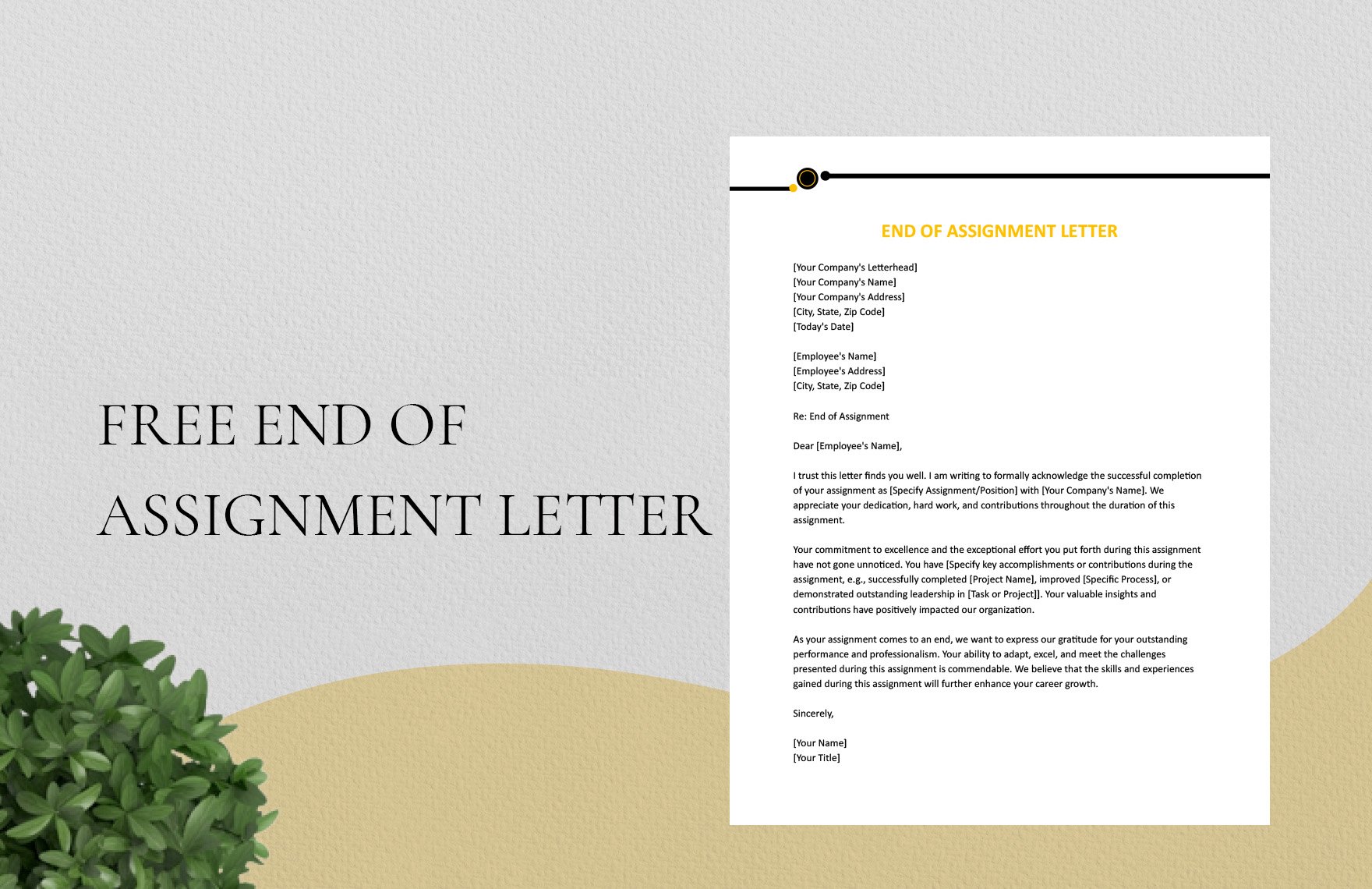
Download this End Of Assignment Letter Design in Word, Google Docs Format. Easily Editable, Printable, Downloadable.
The "End of Assignment Letter" is a versatile document available for download in MS Word, Google Docs, and Apple Pages formats, offering seamless editing and customization options. This letter template is designed to provide a polished and professional way to formally conclude an assignment or project. It is adaptable to both A4 and US letter sizes, ensuring compatibility with various document standards. Users can effortlessly personalize the content, including dates, names, and specific details, to suit their unique requirements. Whether you're bidding farewell to a colleague, employee, or project partner, this editable template simplifies the process and helps you convey your appreciation and closing remarks effectively.
Already a premium member? Sign in
- Microsoft Word
- , Google Docs
You may also like
Get access to world's largest template library & tools.
- Access to 1 Million+ Templates & Tools
- Unlimited access to Design & Documents AI editors
- Professionally Made Content and Beautifully Designed
- Instant Download & 100% Customizable

IMAGES
VIDEO
COMMENTS
For more information on the role of assignments in organizational management, Harvard Business School provides a wealth of resources on organizational behavior. Key Elements of a Letter of Assignment. Introduction: Clearly state the purpose of the letter. Details of the Assignment: Specify the task or responsibility being assigned, including ...
Free Assignment Letter Template Active Voice Communications 2019-10-01T18:31:45+00:00 Assigning content to writers takes time if you do it right. It's important to give your writers as much information as you can so they can create the content you need.
gl.ch. Details. File Format. PDF. Size: 130 KB. Download. The top of the page should have the name of the person or the entity issuing the letter together with their personal information such as the telephone number, email address, and the postal address. Below that it should indicate that it is a letter of assignment to give the form an identity.
That's where an assignment letter comes in handy. After you and a freelancer have agreed on a story, recap the discussion in writing and send your letter (or e-mail message) to the writer. It will help you get the piece you want. Once you've read through the guidelines below, have a look at our sample letter (a downloadable PDF document).
An authentic assessment provides opportunities for students to practice, consult resources, learn from feedback, and refine their performances and products accordingly (Wiggins 1990, 1998, 2014). Authentic assignments ask students to "do" the subject with an audience in mind and apply their learning in a new situation.
The Letter begins with a traditional letter structure, which clearly sets out the sender and the recipient of the Letter (ie the assignor and the assignee), their addresses, and the date of the Letter. The reference number or code that the parties can use to identify this Letter is also set out here. Re: Assignment of the rights under the ...
Instructors can often help students write more effective papers by giving students written instructions about that assignment. Explicit descriptions of assignments on the syllabus or on an "assignment sheet" tend to produce the best results. These instructions might make explicit the process or steps necessary to complete the assignment.
Contract Assignment Agreement. Last revision 01/31/2024. Formats Word and PDF. Size 2 to 3 pages. 4.8 - 105 votes. Fill out the template. This Contract Assignment Agreement document is used to transfer rights and responsibilities under an original contract from one Party, known as the Assignor, to another, known as the Assignee. The Assignor ...
An assignment of contract is simpler than you might think. The process starts with an existing contract party who wishes to transfer their contractual obligations to a new party. When this occurs, the existing contract party must first confirm that an assignment of contract is permissible under the legally binding agreement.
Clearly link each assignment to the course goals and learning outcomes. Break large, high-stakes assignments into multiple, low-stakes assignments. Identify the purpose, audience, and genre (e.g. book review, reflection letter) for the assignment. Design assignments around real-world issues and events to engage and motivate students.
The assignment letter should clearly explain the level of benefits provided and how they are delivered, i.e. in-kind or in cash, bearing in mind the most tax effective form of delivery for the company depending on host country tax legislation. Tax charged on assignment benefits can be considerable, sometimes up to 50% of total assignment costs.
Assignment design principles and strategies: Backwards design, alignment, scaffolding, feedback, and transparency. Applying a principle or strategy to improve an assignment. Developing and using rubrics. Helping students with assignments. Joining an assignment design community: Assignments Across Disciplines.
Format your document. Open a blank word processing document. Set the font to a readable size and style. For example, Times New Roman 12 point works for many people, though you can choose something different if you want. 2. Insert a title. At the top of the page, insert "Assignment Agreement.".
Execution of the Assignment Agreement. Both the assignor and assignee should sign the assignment agreement. Signatures should be notarized if required by the contract or local laws. Notice to the Other Party. Provide notice of the assignment to the non-assigning party. This can be done formally through a letter or as specified in the contract.
Trademark Assignment Agreement. This document allows you to transfer the property rights in a mark or multiple marks. 3.5K downloads. An assignment agreement is a crucial legal document used to consolidate the transfer of rights, titles, and interests, particularly in the realm of intellectual property. Whether it's patent rights, a trademark ...
Begin with a condensed section with the most important information. Secondly, include goals and preparation steps. Clearly highlight important items with bullet points or bold letters. End with the least important information: formatting, page numbers, etc. Make sure you have clearly separated the "getting started" section on your ...
A contract assignment agreement is a binding document between two parties that sets out the terms of the assignment of a contract. It is typically used when one party wishes to assign their rights, responsibilities, obligations, and benefits under a contract to another party. Use this contract assignment agreement template to create a binding ...
Sample letter of assignment. Hopgood Liquidations. 1239 Mercer Street Downsville, WI 54735 . Dear Hopgood Liquidations. This letter is to hereby certify that on July 14 th, 2009, you are to take possession of three (3) Ford Econoline transportation vans from our business, Greenbelt Couriers, for the purpose of liquidation.We certify that all the proceeds from the sale of these 3 vans, minus ...
Mission. The Purdue On-Campus Writing Lab and Purdue Online Writing Lab assist clients in their development as writers—no matter what their skill level—with on-campus consultations, online participation, and community engagement. The Purdue Writing Lab serves the Purdue, West Lafayette, campus and coordinates with local literacy initiatives.
The standardized design elements and formatting guidelines help maintain a professional appearance throughout your work. Presenting your assignments with a polished title page enhances the overall quality and credibility of your content. Visual Appeal: A visually appealing title page grabs attention and sets the tone for your assignment. Our ...
The "End of Assignment Letter" is a versatile document available for download in MS Word, Google Docs, and Apple Pages formats, offering seamless editing and customization options. This letter template is designed to provide a polished and professional way to formally conclude an assignment or project. It is adaptable to both A4 and US letter ...
Assignment #6 - Letter of Agreement/Contract_____ Objective: The ... Assignment #10 - Interview of Design Professional_____ Objective: To introduce you to people in our industry and to start your networking social skills. Interviews must be done in person (no phone interviews) and should only
Editor's Note: Many commercial agreements provide that any assignment by a party requires the written consent of the non-assigning party.The restriction applies both to voluntary, contractual assignments between one of the contract parties and a third-party assignee as well as involuntary assignments resulting from a change in control.
There are tons more ways you can make your design uniquely yours. Download your custom page border templates for free as a JPG, PDF, or PNG file you can print and share anytime. Your project autosaves in your dashboard, so you can return to it whenever you need to make some edits. If you need a batch or two of your page border design, Canva ...
United Airlines - Airline Tickets, Travel Deals and Flights If you're seeing this message, that means JavaScript has been disabled on your browser, please enable JS ...